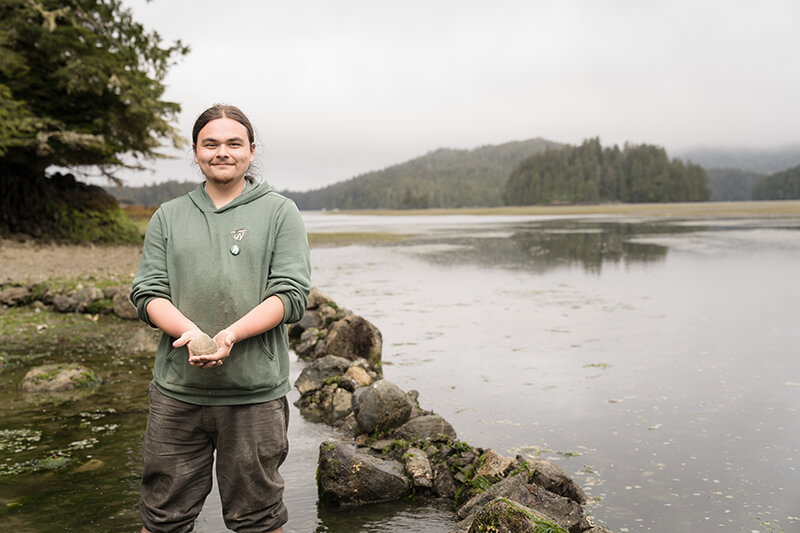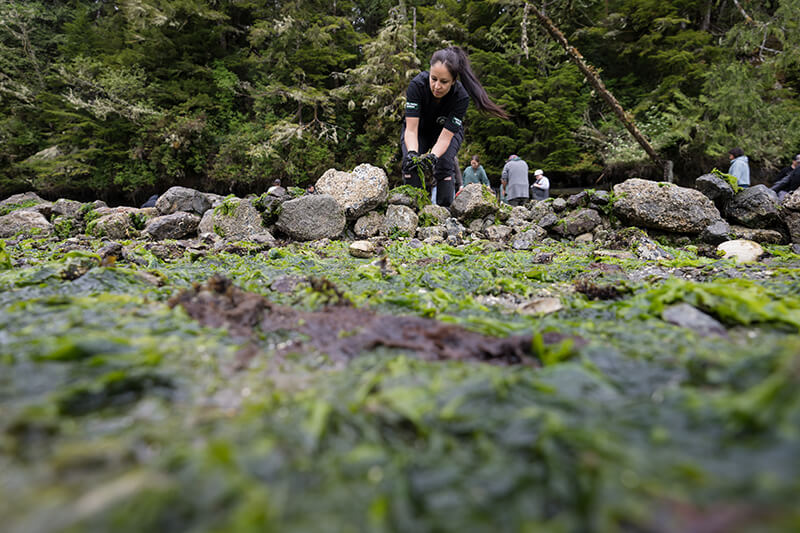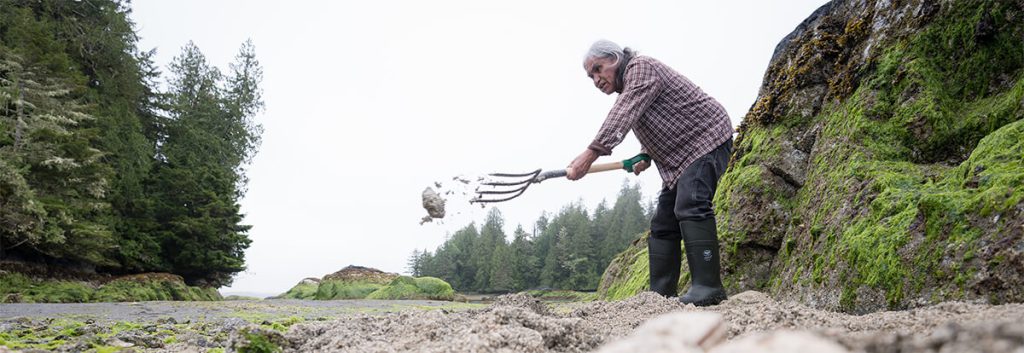
Hughie Watts is from Tseshat Nation and is increasingly concerned about climate and industrial impacts on his territory and way of life.
The 27-year-old father of two says “I couldn’t imagine a world being Nuu-chah-nulth without access to seafood. It’s just a massive part of who we are, feasting, distributing it. Our chiefs had all the seafood, and they would throw big potlatches. And they would show people their wealth and their wealth wasn’t money. It was what they had on their land, what they had access to and what they took care of and all the community put hard work into maintaining it.”
Watts is part of a group of over 100 Nuu-chah-nulth youth aged 12-18, supported by Elders and knowledge holders, who are embarking on a mission to create, monitor, and manage clam gardens throughout the territory.
Clam gardening is a traditional practice that enhances the habitat of intertidal species. It’s been practiced on B.C.’s coast for at least 3,800 years, and involves creating rock walled terraces on the beach so that clams can nest their eggs and are protected. Gardens are maintained through the removal of rocks within the clam bed and turning of sand.
Hayden Seitcher is Tla-o-qui-aht and serves as a Community Coordinator for the Nuu-chah-nulth Youth Warrior Family. The 22-year-old explains that he didn’t know what a clam garden was until a few months ago when fellow Tla-o-qui-aht member Gisele Martin taught him about the ancient practice designed to bring food back to the Nation.
Seitcher says that the time is right to reinvigorate sea gardens. “During COVID we struggled within the community making sure that everyone was fed because a lot of people lost their jobs, their income. We’re hoping that clam gardens can help with food sovereignty and teaching our people again that we can eat local, we can always get food and we don’t really have to worry. We’re teaching our kids to harvest but also to create a clam garden so that it can keep going and so we can take care of it. And so this is a community project so that we can take care of each other.”
Reviving clam gardens throughout Nuu-chah-nulth territory is complicated by overlapping jurisdiction, climate change, and environmental damage. Selecting sites for clam garden restoration includes gauging factors like bio-toxin levels, the presence of algae blooms, and sewage effluent.
“We’ve had trouble restoring some of the existing gardens because of industrial activity and raw sewage,” explains Seitcher “So now we’re creating new ones.”
Seitcher views the establishment of new clam gardens as an assertion of Tla-o-qui-aht presence and stewardship.
“Tens of thousands of tourists visit Tofino and surrounding Tla-o-qui-aht territory every year. Our new clam garden at Meares Island will be an important food source and teaching tool for guests in our territory.”
A little-known fact is that many clam harvesting closures on the coast are due to a lack of monitoring rather than a presence of toxins. Locating a site within a monitored area was the final factor that helped with site selection.
The team has worked with large federal departments like the Canadian Food Inspection Agency, Environment and Climate Change Canada, and Fisheries and Oceans Canada to access much-needed data for new clam garden site selection.

As Tla-o-qui-aht fisheries manager, Andrew Jackson’s job is to look after the resources and the people and his number one priority is safety. Jackson hopes to establish additional bio-toxin monitoring stations throughout the territory to monitor clam gardens old and new.
It’s a lot of work to establish a new clam garden but Jackson says that supply chain issues during the COVID-19 pandemic reinforced his community’s need for food sovereignty.
“People were panicking all over the world, but we just got together, got busy and started harvesting clams, halibut, sea urchin, crab, and salmon. The purpose was to make sure our members didn’t go hungry.”
Jackson says that the Tla-o-qui-aht community harvesting program has continued and is the new normal in his community. The stockpiled foods are replenished and available for community use at potlatches, funerals and other events.
Restoring clam gardens is an important part of the picture. Once established, clam gardens increase food production between 150 and 300% and can be sustained with small inputs of time and care. This investment through the Indigenous Food Systems and Agriculture Partnership Program will have lasting impacts on Nuu-chah-nulth food security.
But as Watts explains, there is more than just clam gardens getting built.
“All our Nations have different ways of doing things so we’re pulling in the collective knowledge of all of our communities. And we’re poking at people that are willing to work with us. And we’re poking at our elders and asking them questions about how we did things. And it’s a team effort, it’s being done collectively from our communities.”
Kyuquot mentor Daniel Blackstone adds that working together side-by-side on the land creates lasting connections and confidence that will impact generations to come.
“Soon enough we will have warriors that can stand up in the community and say this is who I am, this is what I believe in, this is what I am about, this what I want to do. They will be clear about who they are and what they are here for.”
Seitcher feels that rebuilding clam gardens will have a lasting impact for his generation too. “It brings a light to Native culture and reminds people that we are living here, that this is our land and we’re taking care of it.”
Declaration Act Action Plan Action 4.48: Work with the B.C. Indigenous Advisory Council on Agriculture and Food and other Indigenous partners to identify opportunities to strengthen Indigenous food systems and increase Indigenous participation in the agriculture and food sector.

